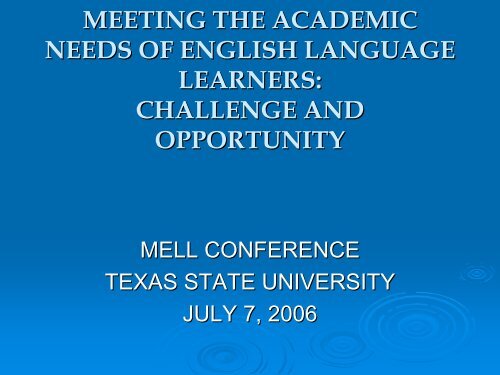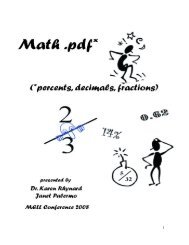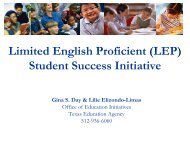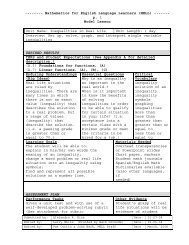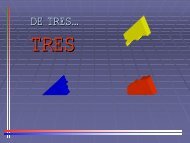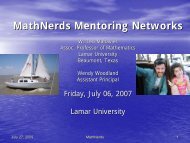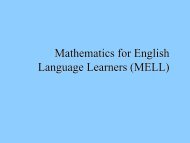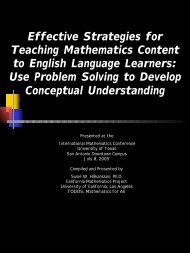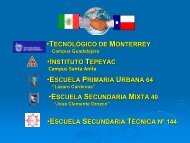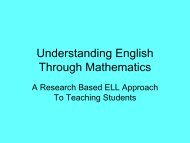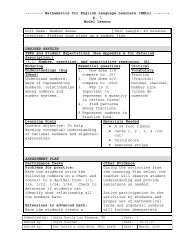Opening Session: Meeting the Challenge - Mathematics for English ...
Opening Session: Meeting the Challenge - Mathematics for English ...
Opening Session: Meeting the Challenge - Mathematics for English ...
Create successful ePaper yourself
Turn your PDF publications into a flip-book with our unique Google optimized e-Paper software.
MEETING THE ACADEMIC<br />
NEEDS OF ENGLISH LANGUAGE<br />
LEARNERS:<br />
CHALLENGE AND<br />
OPPORTUNITY<br />
MELL CONFERENCE<br />
TEXAS STATE UNIVERSITY<br />
JULY 7, 2006
You Might Be A<br />
Teacher IF……
You want to slap <strong>the</strong> next<br />
person who says, “Must be<br />
nice to work 8:00 – 3:20<br />
and have summers free.
You Might Be A<br />
Teacher IF……
You aren’t t sure about<br />
having children of your own<br />
because <strong>the</strong>re’s s no name<br />
you could give a child that<br />
wouldn’t t bring on high<br />
blood pressure <strong>the</strong> moment<br />
you heard it uttered.
You Might Be A<br />
Teacher IF…..
You can tell if it’s a full<br />
moon without ever looking<br />
outside.
You Might Be A<br />
Teacher IF…..
<strong>Meeting</strong> a child’s s parent<br />
instantly answers <strong>the</strong><br />
question, “Why is this kid like<br />
this?”
You Might Be A<br />
Teacher IF…….
When out in public you<br />
feel <strong>the</strong> urge to snap<br />
your fingers at children<br />
you do not know and<br />
correct <strong>the</strong>ir behavior.
You Might Be A<br />
Teacher IF……
You laugh uncontrollably<br />
when people refer to <strong>the</strong> staff<br />
room as <strong>the</strong> “lounge.”
And You Might Be A<br />
Teacher IF…….
“Marking all “A’s” on<br />
report cards would make<br />
your life SO much easier.
Institute <strong>for</strong> Second Language Achievement<br />
16
SCHOOL IMPROVEMENT PROJECT<br />
ENGLISH LANGUAGE LEARNERS<br />
(ELL)<br />
Mission Statement<br />
To assist high potential schools with planning<br />
and implementing effective practices to<br />
enhance language and academic<br />
achievement of <strong>English</strong> language learners.<br />
17
SCHOOL IMPROVEMENT PROJECT<br />
ENGLISH LANGUAGE LEARNERS (ELL)<br />
<br />
<br />
<br />
<br />
Establish a project work team.<br />
Texas A & M University-Corpus Christi<br />
as lead university to invite three to four<br />
System universities to participate.<br />
Create a Project Advisory Committee.<br />
Establish a project website.<br />
Develop prototype <strong>for</strong> online ESL certification- Secondary Teachers.
I S L A<br />
W<br />
E<br />
B<br />
P<br />
A<br />
G<br />
E
SCHOOL IMPROVEMENT PROJECT<br />
ENGLISH LANGUAGE LEARNERS (ELL)<br />
Design, develop, and implement a series of professional development<br />
workshops <strong>for</strong> teachers in under per<strong>for</strong>ming ELL campuses.<br />
Workshops include but will not be limited to <strong>the</strong> following topics:<br />
- Effective Language Programs<br />
- L1 & L2 Literacy Development Programs<br />
- Effective Transitional Bilingual Language Acquisition<br />
- ESL Methodology<br />
Identify materials & resources available to improve ELL student<br />
learning.
School Improvement Project<br />
<strong>English</strong> Language Learners (ELL)<br />
Provide technical assistance to selected ELL campuses which<br />
may include:<br />
- online professional development.<br />
- per<strong>for</strong>mance analysis of ELL students.<br />
- program consultation.<br />
- model campus improvement plans to enhance<br />
ELL student achievement.<br />
- evaluations of campus improvement plans.
The <strong>Challenge</strong><br />
‣ About 32% of <strong>the</strong> Texas population speaks a language<br />
o<strong>the</strong>r than <strong>English</strong> at home.<br />
‣ About 42.7% of Texas students are Hispanic.<br />
‣ About 40% of Hispanic children under eighteen are living<br />
in poverty.<br />
‣ Less than 25% of ELLs passed <strong>the</strong> TAKS in 11 th grade.<br />
‣ It takes 5 – 7 years to acquire academic language<br />
proficiency in <strong>English</strong>.<br />
‣ It takes 2 – 3 years to acquire conversational fluency in a<br />
second language.
Percent Change in Population from<br />
1990 to 2000 <strong>for</strong> Council of Government<br />
Regions in Texas<br />
State of Texas<br />
Alamo Area<br />
Ark-Tex<br />
Brazos Valley<br />
Capital Area<br />
Central Texas<br />
Coastal Bend<br />
Concho Valley<br />
Deep East Texas<br />
East Texas<br />
Golden Crescent<br />
Heart of Texas<br />
Houston-Galveston<br />
Lower Rio Grande Valley<br />
Middle Rio Grande<br />
Nortex<br />
North Central Texas<br />
Panhandle<br />
Permian Basin<br />
Rio Grande<br />
South Texas<br />
South East Texas<br />
South Plains<br />
Texoma<br />
West Central Texas<br />
22.76<br />
21.56<br />
8.79<br />
21.64<br />
21.03<br />
9.63<br />
4.17<br />
16.5<br />
14.22<br />
10.01<br />
12.48<br />
24.56<br />
15.14<br />
6.04<br />
29.12<br />
8.31<br />
1.59<br />
14.49<br />
6.61<br />
4.33<br />
18.33<br />
4.06<br />
39.83<br />
40.41<br />
46.48<br />
0<br />
20<br />
40<br />
60<br />
Percent Change
Population Change in Texas Counties, 1990-2000<br />
Source: Texas State Data Center<br />
Percent Change 2000-2003<br />
< 0.0% (n=68)<br />
0.0 - 9.9% (n=61)<br />
10.0 - 21.9% (n=66)<br />
22.0 - 86.2% (n=59)
Population Change in Texas Counties, 2000-2003<br />
Source: Texas State Data Center<br />
Percent Change 2000-2003<br />
< 0.0% (n=98)<br />
0.0 - 1.9% (n=50)<br />
2.0 - 5.4% (n=53)<br />
5.5 - 28.2% (n=53)
Population Change in Texas Counties, 2000-2004<br />
Source: U.S. Bureau of <strong>the</strong> Census, 2004 County Estimates<br />
Percent Change 2000-2004<br />
< 0.0% (n=103)<br />
0.0 - 1.9% (n=39)<br />
2.0 - 5.4% (n=51)<br />
5.5 - 35.2% (n=61)
Numerical Change in Population by Race/Ethnicity<br />
in Texas <strong>for</strong> 1980-1990 1990 and 1990-2000<br />
2,500,000<br />
2,329,761<br />
2,000,000<br />
1,500,000<br />
1,354,081<br />
1,000,000<br />
941,383<br />
783,036<br />
500,000<br />
283,818<br />
445,293<br />
178,037<br />
307,220<br />
0<br />
Anglo Black Hispanic O<strong>the</strong>r<br />
1980-1990 1990-2000
Percent Change in Population by Race/Ethnicity <strong>for</strong><br />
1980-1990 1990 and 1990-2000 in Texas<br />
88.78<br />
80<br />
81.15<br />
60<br />
53.68<br />
45.35<br />
40<br />
20<br />
10.07<br />
16.77<br />
7.61<br />
22.53<br />
0<br />
100 Percent Change Anglo Black Hispanic O<strong>the</strong>r<br />
1980-1990 1990-2000
Percent Change in Population from 1990 to 2000 by<br />
Race/Ethnicity by Metropolitan Status in Texas<br />
200<br />
Percent Change<br />
180.43<br />
150<br />
100<br />
86.73<br />
50<br />
0<br />
-0.37<br />
21.85<br />
55.05<br />
68.19<br />
35.59<br />
40.29<br />
7.51<br />
32.25 34.24 36.54<br />
28.39<br />
11.05 12.38<br />
0.4<br />
-50<br />
Metropolitan<br />
Central City<br />
Metropolitan<br />
Suburban<br />
Nonmetropolitan<br />
Adjacent<br />
Nonmetropolitan<br />
Nonadjacent<br />
Anglo Black Hispanic O<strong>the</strong>r
72.6<br />
Percent of Texas Population by Age Group<br />
and Ethnicity, 2000<br />
Percent<br />
60.0<br />
57.2<br />
53.0<br />
47.8<br />
44.0<br />
45.0 45.0<br />
43.1<br />
44.4<br />
41.6 41.3<br />
39.5<br />
40.5<br />
38.0 38.4<br />
38.6<br />
40.0<br />
35.3<br />
30.5<br />
20.0<br />
0.0<br />
80.0 Percent<br />
Anglo Hispanic<br />
66.4 67.1<br />
63.5<br />
60.2<br />
16.7<br />
26.7<br />
24.2<br />
22.4<br />
20.6 20.3<br />
< 5 years<br />
5 to 9 years<br />
10 to 14 years<br />
15 to 19 years<br />
20 to 24 years<br />
25 to 29 years<br />
30 to 34 years<br />
35 to 39 years<br />
40 to 44 years<br />
45 to 49 years<br />
50 to 54 years<br />
55 to 59 years<br />
60 to 64 years<br />
65 + years
52.3<br />
Percent of Texas Population by Age Group<br />
and Ethnicity, 2040*<br />
39.8<br />
70.0<br />
69.9<br />
67.8<br />
66.5 65.5 66.0 66.8 66.4<br />
64.3<br />
62.6<br />
60.0<br />
50.0<br />
40.0<br />
30.0<br />
20.0<br />
17.7<br />
19.3 19.9 20.3 19.8 19.3 19.4<br />
20.5 20.6<br />
10.0<br />
0.0<br />
80.0 Percent Anglo Hispanic<br />
37.1<br />
60.6<br />
56.7<br />
55.2<br />
25.3<br />
26.5 27.2<br />
21.9<br />
< 5 years<br />
5 to 9 years<br />
10 to 14 years<br />
15 to 19 years<br />
20 to 24 years<br />
25 to 29 years<br />
30 to 34 years<br />
35 to 39 years<br />
40 to 44 years<br />
45 to 49 years<br />
50 to 54 years<br />
55 to 59 years<br />
60 to 64 years<br />
65 + years<br />
* Projections are shown <strong>for</strong> <strong>the</strong> 1.0 scenario
70.0<br />
Percent<br />
Projected Proportion of Population by<br />
Race/Ethnicity in Texas, 2000-2040*<br />
2040*<br />
60.0<br />
59.2<br />
53.1<br />
53.2<br />
50.0<br />
45.1<br />
46.5<br />
40.0<br />
39.3<br />
37.3<br />
30.0<br />
32.0<br />
30.3<br />
23.9<br />
20.0<br />
10.0<br />
11.6 11.1<br />
3.3<br />
4.5<br />
10.3<br />
5.9<br />
9.2<br />
7.3<br />
8.0<br />
8.9<br />
0.0<br />
2000 2010 2020 2030 2040<br />
Anglo Black Hispanic O<strong>the</strong>r<br />
*Using U.S. Census count <strong>for</strong> 2000 and Texas State Data Center 1.0 population projection scenario <strong>for</strong> 2010-2040.
Median Household Income in 1999 in<br />
Texas by Age of Householder<br />
Thousands<br />
$60<br />
$50<br />
$40<br />
$30<br />
$20<br />
$10<br />
$0<br />
Median Household Income In 1999 in<br />
Texas by Race/Ethnicity of Householder<br />
$60,000<br />
$50,000<br />
$47,162<br />
$50,049<br />
$40,000<br />
$30,000<br />
$29,305 $29,873<br />
$20,000<br />
$10,000<br />
$0<br />
Anglo Black Hispanic Asian
Educational Attainment in 2000<br />
in Texas <strong>for</strong> Persons 25+ Years<br />
of Age By Race/Ethnicity<br />
Percent<br />
< High School<br />
High School<br />
Some College<br />
Hispanic<br />
Black<br />
Anglo<br />
Asian<br />
College or More<br />
0 10 20 30 40 50 60
States Ranked by Median Household<br />
Income in 1999<br />
New Jersey (1)<br />
Connecticut (2)<br />
Maryland (3)<br />
Alaska (4)<br />
Massachusetts (5)<br />
Hawaii (6)<br />
New Hampshire (7)<br />
Cali<strong>for</strong>nia (8)<br />
Delaware (9)<br />
Colorado (10)<br />
$55,146<br />
$53,935<br />
$52,868<br />
$51,571<br />
$50,502<br />
$49,820<br />
$49,467<br />
$47,493<br />
$47,381<br />
$47,203<br />
Texas (30)<br />
$39,927<br />
United States<br />
$41,994<br />
$0 $10,000 $20,000 $30,000 $40,000 $50,000 $60,000 $70,000
States Ranked by Percent High School Graduates<br />
+<br />
in <strong>the</strong> Population 25 Years of Age or Older, 2000<br />
Alaska(1)<br />
Minnesota (3)<br />
Wyoming (3)<br />
Utah (4)<br />
New Hampshire (5)<br />
Montana (6)<br />
Washington (7)<br />
Colorado (8)<br />
Nebraska (9)<br />
Vermont (10)<br />
88.3<br />
87.9<br />
87.9<br />
87.7<br />
87.4<br />
87.2<br />
87.1<br />
86.9<br />
86.6<br />
86.4<br />
Texas (45)<br />
75.7<br />
United States<br />
80.4<br />
0.0 20.0 40.0 60.0 80.0 100.0<br />
Percent
States Ranked by Percent College Graduates +<br />
in <strong>the</strong> Population 25 Years of Age or Older, 2000<br />
District of Columbia (1)<br />
39.1<br />
Massachusetts (2)<br />
Colorado (3)<br />
Connecticut (5)<br />
Maryland (5)<br />
New Jersey (6)<br />
Virginia (7)<br />
Vermont (8)<br />
New Hampshire (9)<br />
Washington (10)<br />
33.2<br />
32.7<br />
31.4<br />
31.4<br />
29.8<br />
29.5<br />
29.4<br />
28.7<br />
27.7<br />
Texas (27)<br />
23.2<br />
United States<br />
24.4<br />
0.0 10.0 20.0 30.0 40.0 50.0<br />
Percent
Projected Percent of Public Elementary and Secondary Enrollment<br />
by Race/Ethnicity in 2000 and Projections <strong>for</strong> 2040*<br />
Percent<br />
70.0<br />
66.3<br />
60.0<br />
50.0<br />
40.0<br />
43.2<br />
39.5<br />
30.0<br />
20.0<br />
14.4<br />
19.9<br />
10.0<br />
2.9<br />
8.3<br />
5.5<br />
0.0<br />
2000 2040<br />
Projection Year<br />
Anglo Black Hispanic O<strong>the</strong>r<br />
* Projections are shown <strong>for</strong> <strong>the</strong> 1.0 scenario
Projected Percent of Public University Enrollment<br />
by Race/Ethnicity in 2000 and Projections <strong>for</strong> 2040*<br />
Percent<br />
70.0<br />
61.5<br />
60.0<br />
50.0<br />
44.5<br />
40.0<br />
32.3<br />
30.0<br />
21.3<br />
20.0<br />
15.1<br />
10.0<br />
10.3<br />
6.9<br />
8.1<br />
0.0<br />
2000 2040<br />
Projection Year<br />
Anglo Black Hispanic O<strong>the</strong>r<br />
* Projections are shown <strong>for</strong> <strong>the</strong> 1.0 scenario
Percent Change in Enrollment in Selected<br />
Elementary and Secondary School Programs<br />
in Texas, 2000 to 2040*<br />
Bilingual/ESL<br />
186.8<br />
Economically Disadvantaged<br />
119.9<br />
Gifted and Talented<br />
48.5<br />
Immigrants<br />
183.0<br />
Limited <strong>English</strong> Proficiency (LEP)<br />
188.1<br />
Special Education<br />
64.7<br />
Title I<br />
101.9<br />
Career and Technology Education<br />
69.9<br />
0.0 50.0 100.0 150.0 200.0 250.0<br />
*Projections are <strong>for</strong> <strong>the</strong> 1.0 Scenario<br />
Percent Change
* Projections are shown <strong>for</strong> <strong>the</strong> 1.0 scenario<br />
$60,000<br />
Average Household Income<br />
in Texas, 2000-2040*<br />
2040*<br />
(in 2000 Dollars)<br />
$54,441<br />
$52,639<br />
$50,000<br />
$50,903<br />
$49,326<br />
$47,883<br />
$40,000<br />
$30,000<br />
2000 2010 2020 2030 2040
Projected Percent of Households in Poverty by<br />
Family Type in Texas, 2000 and 2040<br />
Percent in Poverty<br />
35.0<br />
30.0<br />
30.0<br />
26.7<br />
25.0<br />
20.0<br />
15.4<br />
15.0<br />
17.0<br />
18.9<br />
18.9<br />
14.4<br />
16.6<br />
15.0<br />
11.4<br />
11.8<br />
10.0<br />
7.5<br />
5.0<br />
0.0<br />
Family<br />
Households<br />
Married<br />
Couple<br />
Male<br />
Householder<br />
Female<br />
Householder<br />
Nonfamily<br />
Households<br />
Total<br />
Households<br />
2000 2040<br />
* Projections are shown <strong>for</strong> <strong>the</strong> 1.0 scenario
The mark of a truly<br />
educated man is to be<br />
moved deeply by<br />
statistics.<br />
George Bernard Shaw
Steve Murdock<br />
Texas State Data Center<br />
Phone 210 – 458 - 6530<br />
Fax 210 – 458 - 6540<br />
Website txsdc.utsa.edu
Guidance (not threats) from <strong>the</strong> Courts and <strong>the</strong> Law:<br />
What is “A Meaningful Education” <strong>for</strong> LM students?<br />
There is no equality of treatment merely by providing students with <strong>the</strong><br />
same facilities, textbooks, teachers and curriculum; <strong>for</strong> students who do<br />
not understand <strong>English</strong> are effectively <strong>for</strong>eclosed from any meaningful<br />
education.”<br />
Lau v. Nichols (1974), U.S. Supreme Court<br />
Plaintiff: Chinese-American community in San Francisco, CA<br />
Programs serving LEP/ELL students must:<br />
(1) Be based on “sound educational <strong>the</strong>ory”.<br />
(2) Be implemented effectively, with adequate resources and personnel<br />
(3) Be evaluated and found successful in two areas: <strong>the</strong> teaching of<br />
language (<strong>English</strong> and o<strong>the</strong>rs) and in access to <strong>the</strong> full curriculum<br />
(math, social studies, science)<br />
Castaneda v. Pickard, 1981, U.S. Fifth Circuit Court of Appeals<br />
Plaintiff: Mexican-American community in Raymondville, TX
Goal: Equal Educational Opportunity <strong>for</strong> all<br />
students as defined by equal results, not<br />
only by intents or inputs.<br />
Equal Educational Opportunity Act, 1974.<br />
Goal: Addressing a “meaningful<br />
education” using demonstrably effective<br />
programs that lead to long-term parity,<br />
not with minimalist programs that attempt<br />
to ‘just get by’.<br />
Thomas and Collier
IN TRESPASS TO TRY TITLE TO TRACT OF LAND WHERE<br />
THE STATE IN ORDER TO ESTABLISH THAT TRACT HAS A<br />
VACANCY IN PUBLIC DOMAIN ATTACKED VALIDITY OF A<br />
CORRECTED PATENT GRANTED TO DEFENDANTS’<br />
PREDECESSOR. COURT OF CIVIL APPEALS BY REVERSING<br />
JUDGMENT OF TRIAL COURT IN FAVOR OF STATE HOLDING<br />
CORRECTED PATENT VOID, AND BY DENYING RECOVERY TO<br />
STATE, DIRECTLY UPHELD EXISTENCE OR CORRECTED<br />
PATENT SO AS TO PRECLUDE STATE BECAUSE OF STARE<br />
DECISIS, FROM THEREAFTER CHALLENGING VALIDITY OF<br />
CORRECTED PATENT AGAINS SAME DEFENDANTS.<br />
ALEXANDER v. STANOLIND OIL & GAS CO. (CIV.APP.1917) 192 S.<br />
W. 781,<br />
REF. N. R. E.
Numbers<br />
‣ Rei<br />
‣ Ichi<br />
‣ Ni<br />
‣ San<br />
‣ Shi<br />
‣ Go<br />
‣ Roku<br />
‣ Shichi<br />
‣ Hachi<br />
‣ Ku<br />
‣ Ju
Read <strong>the</strong> paragraph below and answer <strong>the</strong><br />
questions that follow.<br />
A hair raising century by Australian opener Greene<br />
Wood on Friday set England back on its heels in <strong>the</strong> third<br />
test at <strong>the</strong> Melbourne Cricket Ground. Un<strong>for</strong>tunately, living<br />
dangerously eventually cost <strong>the</strong> Australians <strong>the</strong> match.<br />
Wood was caught out of his crease on <strong>the</strong> first over after<br />
lunch. Within ten more overs, <strong>the</strong> Australians were<br />
dismissed. Four were dismissed by dangerous running<br />
between balls from <strong>the</strong> batsmen’s wickets. The three<br />
remaining batsmen were caught by <strong>English</strong> fieldsmen. One<br />
was caught as he tried <strong>for</strong> a six. When <strong>the</strong> innings were<br />
complete <strong>the</strong> Australians had fallen short of <strong>the</strong> runs scored<br />
by <strong>the</strong> <strong>English</strong>.<br />
Were you able to understand <strong>the</strong> paragraph?<br />
Could you explain it to someone else?<br />
If not, what would help you to understand it better?
Foreign Languages Offered and Age of Introduction<br />
Country<br />
1 st Foreign<br />
Language<br />
Starting<br />
Age<br />
Additional Languages<br />
Australia<br />
Austria<br />
Czech Republic<br />
Finland<br />
Germany<br />
Italy<br />
Luxembourg<br />
Spain<br />
Thailand<br />
United States<br />
French 6 German, Greek, Italian, Japanese<br />
<strong>English</strong> 6 French, Italian<br />
<strong>English</strong> and German 9 French, Russian, Spanish<br />
<strong>English</strong> or o<strong>the</strong>r 9 Swedish, Finnish, German, French,<br />
Russian, Spanish, Italian<br />
<strong>English</strong> or o<strong>the</strong>r 8 French, Spanish, Russian, Italian, Turkish<br />
<strong>English</strong> 8 French, German, Spanish, Russian<br />
German and French 6 or 7 <strong>English</strong>, Italian, Spanish<br />
<strong>English</strong> 8 French, German, Italian, Portuguese<br />
<strong>English</strong> 6 French, German, Chinese, Japanese,<br />
Arabic<br />
Spanish 14 French, German Japanese
Stages of Language Acquisition and Development in <strong>the</strong> Child<br />
Vocabulary –<br />
Estimates of Vocabulary –<br />
1 year 3 words<br />
2 years 272 words<br />
3 years 896 words<br />
4 years 1540 words<br />
5 years 2072 words<br />
6 years 2562 words<br />
By first grade a child could possibly have an active vocabulary of 5099 different<br />
words.<br />
Sentence Length –<br />
18 months Usually 1 word length<br />
28 months 2 – 3 words length<br />
3.5 years Complete sentences averaging about 4 words<br />
in length, although capable of producing<br />
occasional sentences that are 20 – 30 words.<br />
5 – 6 years -The average sentence is about 5 words in length.<br />
9.5 years -The oral sentence is about 6 – 7 words, with an<br />
average written length of 11 words<br />
15 years -About 17 words<br />
Adult<br />
-About 20 words
Levels of Language Acquisition<br />
‣ Pre-Production<br />
Production<br />
‣ Early Production<br />
‣ Speech Emergence<br />
‣ Intermediate Fluency<br />
‣ Advanced Fluency
Literacy Development Instructional Sequence<br />
Intermediate<br />
Abilities<br />
Emergent<br />
Literacy<br />
Early Literacy<br />
Preparation to Literacy
Language Proficiency<br />
SUP MODEL<br />
CUP MODEL<br />
Separate Underlying Proficiency<br />
Common Underlying Proficiency<br />
From Cummins, 1981
FIGURE 1-A Working Model <strong>for</strong> Creative Construction in L2<br />
Acquisition*<br />
Internal Processing<br />
Personality<br />
Motivation &<br />
Attitude<br />
Age<br />
Language<br />
Environment<br />
Filter<br />
Organizer<br />
Monitor<br />
Learner’s<br />
Verbal<br />
Per<strong>for</strong>mance<br />
First Language<br />
Access to language
Cognitively<br />
Undemanding<br />
Communication<br />
1 st Quadrant 2 nd Quadrant<br />
Context<br />
Art, music, P.E., Face to<br />
Face conversation, Visual<br />
clues, Simple directions<br />
Telephone conversations,<br />
Written descriptions,<br />
Graphic organizers,<br />
Context<br />
Embedded<br />
Communication<br />
3 rd Quadrant<br />
Demonstrations, “Hands<br />
on” learning, Social<br />
Studies projects,<br />
Science experiments<br />
4 th Quadrant<br />
Reading a textbook,<br />
Explanation of abstract<br />
concepts, Lectures with few<br />
illustrations, Writing<br />
Reduced<br />
Communication<br />
Cognitively<br />
Demanding<br />
Communication
When you know<br />
You know<br />
Then you don’t know<br />
When you know<br />
You don’t know<br />
Then you KNOW
Program Models <strong>for</strong><br />
<strong>English</strong> Language<br />
Learners
Immersion:<br />
No instructional support is provided by a trained<br />
specialist. This is NOT a program model, since it is in<br />
non-compliance with federal standards as a result of<br />
<strong>the</strong> Supreme Court decision in Lau vs. Nichols.
<strong>English</strong> as a Second Language (ESL) or<br />
<strong>English</strong> to Speakers of O<strong>the</strong>r Languages<br />
(ESOL)<br />
All Instruction through <strong>the</strong> majority language.<br />
Elementary Education:<br />
• Structured immersion: Taught by a bilingual/ESL teacher in a self<br />
contained classroom, but all instruction is conducted through<br />
<strong>English</strong> (all day).<br />
• ESL or ESOL self-contained taught through academic content (all<br />
day)<br />
• Inclusion ESL taught in a regular classroom by an ESL teacher.<br />
• ESL or ESOL pullout (from 30 min. to half-day)
<strong>English</strong> as a Second Language (ESL) or<br />
<strong>English</strong> to Speakers of O<strong>the</strong>r Languages<br />
(ESOL) cont’d:<br />
Secondary Education:<br />
•ESL or ESOL taught through academic content or sheltered<br />
<strong>English</strong><br />
•ESL or ESOL taught as a subject
Transitional Bilingual Programs: Academic<br />
instruction through each language<br />
depending on <strong>the</strong> language needs of <strong>the</strong><br />
students, with gradual transition to all<br />
majority language in approximately 2 – 3<br />
years.
Maintenance Bilingual Programs:<br />
Academic instruction half a day through each language.<br />
• For grades K – 5 or 6: Ideally, this type of program<br />
was planned <strong>for</strong> Grades K – 12, but has rarely been<br />
implemented beyond elementary level in U.S.
Bilingual Immersion Programs<br />
Academic instruction through L1 and L2 <strong>for</strong><br />
Grades K – 12. Originally developed <strong>for</strong><br />
language minority students in Canada; often<br />
used as <strong>the</strong> model <strong>for</strong> two-way bilingual<br />
education in <strong>the</strong> U.S.
Two-way Immersion and One-<br />
Way Immersion are also dual<br />
language programs.
The 50 – 50 Model<br />
(in Canada called partial immersion)<br />
•Grades K – 5 or 6: Academic instruction half a day<br />
through each language.<br />
•Grades 6 0r 7 -12: 60% of academic instruction<br />
through majority language and<br />
40% through minority language.
The 90 – 10 Model<br />
(in Canada, referred to as early total immersion)<br />
•Grades K – 1: All or 90% of academic instruction through minority<br />
language<br />
•Grade 2: One hour of academic instruction through majority language<br />
added.<br />
•Grade 3: Two hours of academic instruction through majority language<br />
added.<br />
•Grades 4-5 or 6: Academic instruction half a day through each<br />
language.<br />
•Grades 6 or 7-12: 60% of academic instruction through majority<br />
language and 40% through minority language.
Characteristics Common to Effective<br />
Programs<br />
Fred Genesee, Kathryn Lindholm-Leary,<br />
Leary,<br />
William Saunders, Donna Christian (2005)<br />
‣ Attitude that “All Children Can Learn.”<br />
‣ Positive school environment.<br />
‣ Challenging and meaningful curriculum.<br />
‣ Alignment of curriculum to high standards.<br />
‣ Administrators and teachers that know<br />
and understand <strong>the</strong>ory and goals of program and<br />
implement best practices <strong>for</strong> ELLs.
Characteristics Common to<br />
Effective Programs<br />
‣ Integrate ra<strong>the</strong>r than segregate students.<br />
‣ See <strong>the</strong> program as an enrichment model.<br />
‣ Program is sustained over time.<br />
‣ Consistent assessment of literacy and<br />
academic development.<br />
‣ Language development strategies are<br />
incorporated into <strong>the</strong> program.
SIOP<br />
(Sheltered Instruction Observation Protocol)<br />
A Model of Sheltered Instruction<br />
(Short, Echevarria, 2002)<br />
‣ Identify <strong>the</strong> language demands of <strong>the</strong> content course.<br />
‣ Plan language objectives <strong>for</strong> all lessons and make <strong>the</strong>m<br />
explicit to students.<br />
‣ Emphasize academic vocabulary development.<br />
‣ Activate and streng<strong>the</strong>n background knowledge.
SIOP<br />
(Sheltered Instruction Observation Protocol)<br />
(continued)<br />
• Promote oral interaction and extended academic<br />
talk.<br />
• Review vocabulary and content concepts.<br />
• Give students feedback on language use in class.
ELL Effective Instruction<br />
C. Mehochoko, , Kern Co. Superintendent (2006)<br />
Echevarria, , J., Vogt, M.E., & Short, D. Making Content<br />
Comprehensible <strong>for</strong> <strong>English</strong> Language Learners (2004)<br />
‣ Preparation<br />
‣ Content objective is related to state<br />
content standard.<br />
State standard is posted but not referred<br />
to during <strong>the</strong> lesson------<br />
------Teacher states<br />
content standard at <strong>the</strong> beginning of <strong>the</strong><br />
lesson, during <strong>the</strong> lesson, and at <strong>the</strong><br />
conclusion of <strong>the</strong> lesson.
Preparation continued<br />
‣ Language objective is clearly defined.<br />
Language objective is posted but not<br />
referred to during <strong>the</strong> lesson --------<br />
Teacher states <strong>the</strong> language objective<br />
at <strong>the</strong> beginning of <strong>the</strong> lesson, during <strong>the</strong><br />
lesson, and at <strong>the</strong> conclusion of <strong>the</strong><br />
lesson.
Preparation continued<br />
‣ Supplementary materials (graphic<br />
organizers, visuals, multimedia) are used.<br />
One supplementary material is referred<br />
to and used only briefly during <strong>the</strong> lesson.<br />
Two or more supplementary materials<br />
are referred to and used consistently (as<br />
needed) during <strong>the</strong> lesson.
Preparation continued<br />
‣ Content is adapted <strong>for</strong> all students’<br />
language levels.<br />
Slight modification of content is carried<br />
out during <strong>the</strong> lesson.<br />
Adaptation of content is present early<br />
on in <strong>the</strong> lesson and is used and referred<br />
to throughout <strong>the</strong> lesson.
Preparation continued<br />
‣ Integration of language skills (listening,<br />
speaking, reading, and writing) is evident<br />
in observed content area.<br />
In isolation , one language skill is briefly<br />
covered by <strong>the</strong> teacher but is not referred<br />
to again during <strong>the</strong> lesson.<br />
Integration of language skills is evident<br />
throughout <strong>the</strong> lesson.
Environment<br />
‣ Environment supports language<br />
acquisition beyond direct instruction (word<br />
walls, reference charts, visual cues)<br />
‣ Room environment promotes fluency and<br />
is grade level appropriate.
Teaching Strategies<br />
‣ Consistent use of scaffolding techniques.<br />
‣ Use of a variety of questioning types.<br />
(Bloom’s s Taxonomy)<br />
‣ Vocabulary is explicitly taught<br />
‣ Vocabulary instruction focuses on <strong>the</strong><br />
“mortar” as well as <strong>the</strong> “bricks. bricks.”<br />
‣ Students are engaged in lesson 90%-<br />
100% of <strong>the</strong> time.
Interactions<br />
‣ There are frequent opportunities exist <strong>for</strong><br />
interaction and discussion between<br />
teacher to student and student to student.<br />
‣ Interactive learning structures (partners,<br />
small groups) support objectives.<br />
‣ Appropriate amount of student wait time<br />
<strong>for</strong> student responses.
Assessment<br />
‣ Ongoing assessment is evident during <strong>the</strong><br />
lesson.<br />
‣ Assessment drives instruction and<br />
planning.<br />
‣ Review of key concepts and vocabulary.<br />
‣ Provides regular feedback to students.
General Principles and Strategies<br />
<strong>for</strong> Teaching all ELL Students<br />
‣ Increase comprehensible input-non<br />
non-verbal clues<br />
such as pictures, objects, gestures, intonation,<br />
graphic organizers, peer tutoring.<br />
‣ Increase interaction/opportunities to use <strong>the</strong>ir<br />
language skills in real communication<br />
‣ Increase opportunities <strong>for</strong> higher order thinking-<br />
think aloud-modeling<br />
“thinking language.”
General Principles and Strategies<br />
continued<br />
‣ Use Total Physical Response techniques.<br />
‣ Incorporate Cooperative learning<br />
structures in teaching.<br />
‣ Set up dialogue journals.<br />
‣ Use native language support when<br />
possible. Rely on cognates. Point out<br />
specifics about vocabulary.<br />
‣ Realia strategies-”Hands on”
General Principles and Strategies<br />
continued<br />
‣ Simplify instructions if possible.<br />
‣ Make it culturally relevant or personal to<br />
students.<br />
‣ Whenever possible, supplement a lesson<br />
with bilingual materials.<br />
Northwest Regional Educational Laboratory<br />
(2006) www.nwrel.org
Are <strong>the</strong>se correct?<br />
9 + 1 = 10<br />
7 + 3 = 10<br />
7 + 6 = 1<br />
8 + 6 = 2<br />
12 + 4 = 4<br />
1 + 5 = 6
Institute <strong>for</strong> Second Language Achievement<br />
Texas A& M University-Corpus Christi<br />
100


